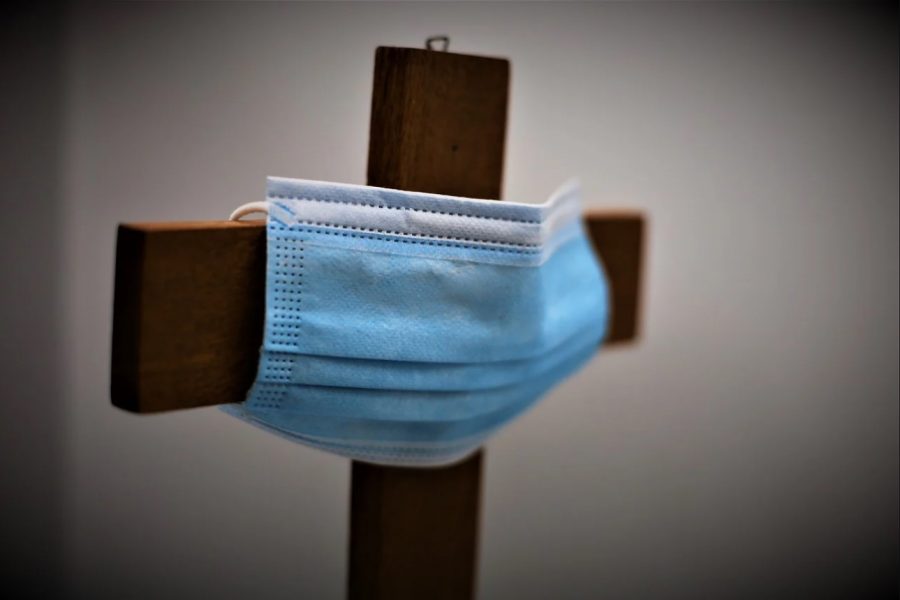Opinion | Pritzker’s defense of religion is superior to SCOTUS
A mask lays on a cross
Jun 8, 2020
As states curb the spread of COVID-19, some have begun phased reopenings with consideration of risks to public health. Governor J.B. Pritzker felt pressure through the Supreme Court to loosen COVID-19 restrictions on places of worship as Illinois enters Phase 3 of the reopening plan.
As California similarly transitioned into their second phase, many religious people were disheartened by restrictions on religious gatherings under Governor Gavin Newsom’s executive orders. Under California’s guidance, places of worship must “limit attendance to 25% of building capacity or a maximum of 100 attendees, whichever is lower.” Simultaneously, most retail stores and industries are allowed to reopen under guidelines lacking attendance caps.
The South Bay United Pentecostal Church litigated, pursuing a court order to challenge the occupancy restrictions, hoping to abide by other state guidelines such as social distancing and hygienic consciousness. Chief Justice Roberts soon delivered the divided 5-4 decision of the Supreme Court, denying to grant injunctive relief to the church.
Roberts’ opinion asserts the restrictions are consistent with the First Amendment because secular gatherings involving extended close proximity such as concerts are subject to similar restrictions. He further argued it is the role of the states to protect the health and safety of their citizens in response to medical uncertainty without “second-guessing by an unelected federal judiciary.”
Any fan of originalism would normally give a standing ovation to Roberts’ opinion. Even Justice Scalia agreed the First Amendment does not grant immunity to religious activity in conflict with the law in the case Employment Division, v. Smith (1990).
Get The Daily Illini in your inbox!
Yet, the conservative justices dissented because there’s an Achilles’ heel to Roberts’ opinion. Why are places of worship decisively dissimilar to less restricted establishments such as retail shops? He argues they’re distinct because unlike places of worship, “people neither congregate in large groups nor remain in close proximity for extended periods” in them.
Is that really the case? Like others not interested in starving, I’ve visited the grocery store during the pandemic. I’ve waited outside in lines wearing a mask to be admitted. I steered my desanitized shopping cart down tight aisles packed with shoppers as I perused the shelves. I stood in socially distanced checkout lines wrapping around the store. Shoppers commonly come into relatively close proximity and the lengthy lines ensure everyone remains there for an extended period.
Justice Kavanaugh’s dissent contends a similar stance. Applying limits to places of worship but not other establishments entails the restrictions aren’t neutrally applicable to secular and religious institutions, hence violating the First Amendment. Such a unique ban would require California to follow strict scrutiny, fulfilling a compelling governmental interest and being narrowly tailored to accomplish the goal as minimally restrictive as possible.
Public health is inarguably a compelling interest, but California fails to narrowly tailor their regulations. They fail to explain why religious institutions should uniquely be subject to occupancy caps. As Justice Kavanaugh nicely said, “The State cannot assume the worst when people go to worship but assume the best when people go to work or go about the rest of their daily lives in permitted social settings.”
With these restrictions come serious costs. Christians haven’t been able to attend mass for months, Jews have scaled back holidays spanning from Purim to Shavuot and Muslims have forgone mosque-reliant Friday prayers and face the potential cancellation of the annual pilgrimage Hajj.
To many Americans, religion is an essential activity. It’s why the religious community at the University of Illinois has innovated to continue practicing their beliefs in new ways. It’s why a Californian church fought so hard to challenge an executive order in the Supreme Court. It’s why President Trump, despite his disregard or ignorance of the 10th Amendment, has rallied for the opening of religious institutions.
Governor Pritzker was pressured by local churches to reopen under extremely similar circumstances to the California case. He could have continued the ten person limit on religious gatherings and relied on the precedent of the California case to uphold his order. Yet, Pritzker lifted the mandatory restrictions for churches, opting to just encourage them to follow safety guidelines at their discretion.
As a conservative, I never expected to, but I’m applauding Pritzker for an excellent move. He has set an example of how governors should seek to actively work with religious leaders to reopen gradually so that they, like other establishments, may innovate their services to cater to the needs of the community in these dire times. I pray we see more of that soon.
Matthew is a junior in LAS.






